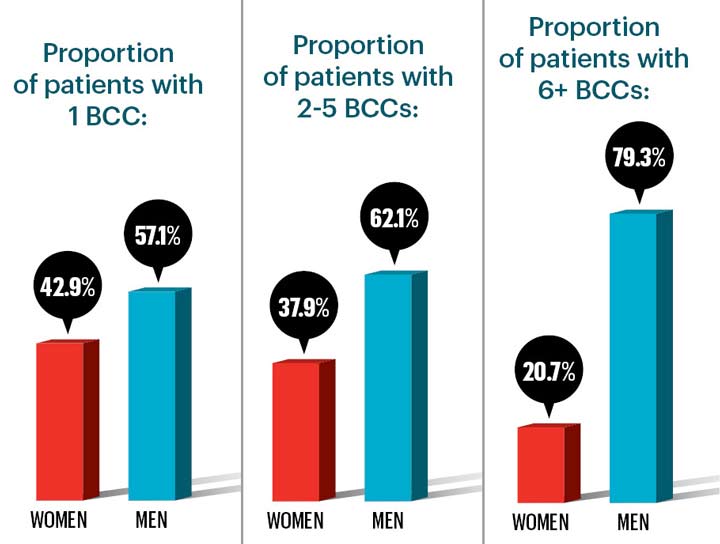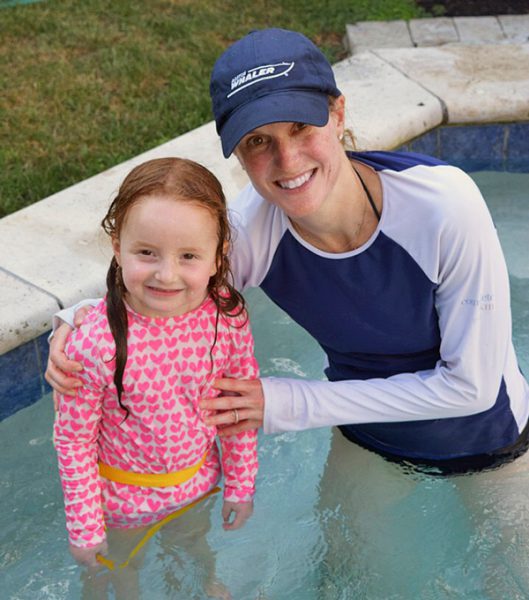Dermatologist Julie K. Karen, MD, says she taught all her “boys” well, including her husband, Jonathan, father-in-law, Papa Robert, and two boys, Alex and Andrew: Sun protection (used on this fishing trip in Cabo San Lucas), is not negotiable.
In the fight against skin cancer, men are way behind the women. What can we do to help those with the Y chromosome catch up?
By Jen Singer
When my kids were in middle school, I was a youth soccer coach who spent half of most pregame warm-ups trying to sell my players on the benefits of sunscreen. Before one game, I attempted to get my 13-year-old goalie, Isaac, to slather on some sunscreen that I kept in my coach’s bag. As we stood in the sun on the artificial turf — which is essentially dark-green plastic — Isaac declared, “I only wear sunscreen at the beach.” I replied, “Wow. The sun only touches you when you’re near the ocean?” I never did convince Isaac to protect himself.
My own boys, however, were used to being chased across the sand at our community lake until I caught them and covered every inch of skin not covered by their swimsuits with sunscreen. My minivan was filled with various boy-sized hats that I’d drop onto their heads while they were busy at the playground, and half-used sunscreen bottles rolled across the floor whenever I hit the brakes. For boys, half the battle is getting them to stand still long enough to protect them from the sun. The other half is making them understand why they need to.
The Great Gender Divide
In skin cancer statistics, there’s a striking gender gap. Though more people are diagnosed with skin cancer each year in the U.S. than all other cancers combined, there are a disproportionate number of men in those statistics. That includes melanoma, the most dangerous of the three most common types of skin cancer.
About 57 percent of people who are diagnosed with one basal cell carcinoma (BCC) are men. When the number of BCCs increases, so does the gender gap. Sixty-two percent of people who are diagnosed with two to five BCCs are men, and among those with six or more BCCs, a whopping 80 percent are male. For more dangerous skin cancers, the news is even worse. Men account for more than half of new cases of invasive melanoma — and almost twice as many deaths.
Gender Gap in the Most Common Type of Skin Cancer

An estimated 4.3 million cases of basal cell carcinoma are diagnosed in the U.S. each year. Men are bearing the brunt of it.
Many more men than women develop melanoma after age 49, possibly the result of a lifetime of sun exposure and poorer sun protection. It’s a cumulative effect from years of doing yardwork without a hat, going for a run without sunscreen and shoveling snow from the walk while unprotected from the sun’s rays because “it’s winter.” (Until age 49, more women than men develop melanoma. Many experts attribute this to the use of tanning beds, as nearly 8 million women versus about 2 million men tan indoors.)
In 2018, an estimated 55,000 new cases of invasive melanoma will be diagnosed in men. In women, it’s an estimated 36,000 cases. Also, that’s a jump of about 3,000 cases in men compared with about 1,000 in women. Clearly, there’s more work to do in communicating the need for sun protection and early detection. I wanted to learn more about this gender gap, so we called in a top expert who is not only an experienced dermatologist, but also a mom of three.
“Men may not be deliberately tanning as much, but if they go fishing or go out for a run, they tend not to lather up with sunscreen,” explains Julie K. Karen, MD, who specializes in the diagnosis and treatment of skin cancer at CompleteSkinMD in New York City. She is also a clinical assistant professor in the Ronald O. Perelman Department of Dermatology at NYU Langone Medical Center. “When men get hot, they take off their shirt, and they just don’t think about the consequences. In general, they’re a little lazier than women are about taking proactive measures to protect themselves from sun damage.”
Women Have Some Advantages
While the vast majority of basal cell and squamous cell carcinomas (SCCs) are caused by sun exposure, Dr. Karen says that women’s long hair may help protect them from developing some of those skin cancers. “It’s way more common to see nonmelanoma skin cancer on the scalp and ears of men than women,” she says, adding that men experience more precancerous lesions, such as actinic keratosis, on the scalp and ears. “We believe this difference is due in part to the protective effect of long hair on women.”
“Men, over their lifetime, probably get a lot more unprotected sun exposure,” she explains. The solution is better sun protection, including using sunscreen and wearing hats, especially over thinning hair. And that’s about good habits, which, when it comes to skin care, women tend to perform more diligently.
“I’m obsessed with protecting my kids’ skin. They do not swim without a swim shirt. I’m very strict on sun protection.”
“Women get smart and use sunscreen because they don’t mind using moisturizer,” Dr. Karen says. For women, adding sunscreen to their daily skin care routines isn’t much of a stretch. “The antiaging aspects are motivating for women, too,” she says: “About 90 percent of the changes that we call aging, including wrinkles, sunspots and textural abnormalities, are actually attributable to UV exposure. That should motivate men, too, but it’s still really hard to get a man to wear sunscreen on his face every day.” It’s just not a part of men’s daily routine, which generally consists of shaving, brushing teeth, combing hair and heading out for the day. They don’t even think about their skin — until there’s a problem.
Men Don’t Get Their Skin Checked
Unless the women in their life make them do it, that is. “Women in their reproductive years go to the doctor all the time, so at least someone is looking at their skin,” says Dr. Karen. As a result, they may be more likely to be referred to a dermatologist. “Women comprise the vast majority of the patients that I see.”
Men, however, are less likely to examine their own skin and not as likely to visit a doctor. That’s where women are men’s best health advocates. Often, men visit Dr. Karen because a wife or girlfriend made the appointment for them. “I would say at least half the time, the man says, ‘She saw some funny-looking moles on my back,’” she says.
For women, the deadliest cancers appear on the legs, but the number one place men develop melanoma is on the trunk, and that causes additional problems. “Men cannot see the area of their body that’s at the highest risk for developing a melanoma, which is the back. And that means they don’t detect something if it is starting to bleed, scab, change or grow.” It’s crucial to catch melanoma early while it’s treatable. “If you catch it early, it is 100 percent curable,” she says. “But if you wait even a few months too long, it can be the difference between life and death.”
“Men cannot see the area of their body that’s at the highest risk for developing a melanoma, which is the back. And that means they don’t detect something if it is starting to bleed, scab, change or grow.”
It’s important to make an appointment with a dermatologist as soon as an irregular mole or unusual spot is detected. Women “wise up,” Dr. Karen says, because they’ll follow advice about sun protection and regular skin screenings. “Men are more likely to wait until there is a problem and then try to fix it, so they’re always playing catch-up.”
Teach Good Sun Protection Habits
While the gender gap persists, in recent years, the long-term rapid rise in melanoma cases has at least begun to slow. The Skin Cancer Foundation believes that educational efforts about sun protection and the dangers of sunburns are starting to take hold.
There’s a long lag time of many years, though, between a bad burn and skin cancer, so it’s important to arm children and adolescents, boys and girls, with greater awareness and better skin protection habits from a young age. This includes using sunscreen not just at the beach, but on the playground, on the soccer field, at the fishing hole and anywhere else they’re in the sun.
Two studies show that daily sunscreen use reduces the risk of developing SCC by about 40 percent and melanoma by 50 percent when used as directed. “Make it a habit and make it non-negotiable,” advises Dr. Karen. Warn your sons about the areas where they’re more likely to develop skin cancer: the trunk, the ears and the scalp. Encourage them to wear hats and sunglasses when they’re outdoors, and, as they get older, to have their skin checked regularly.

Dr. Karen, with her daughter, Kate, then 4, says swim shirts are mandatory, as is water-resistant sunscreen, reapplied frequently.
Sun-protective clothing makes a big difference, too. Dr. Karen has two boys, 11 and 8, and a 5-year-old girl. “I’m obsessed with protecting their skin,” she says. “They do not swim without a swim shirt. When my boys were younger, if they went to a swim party indoors, they’d still wear a swim shirt because they thought it was part of a bathing suit. It’s a little harder with my daughter, who only wants to wear a bikini. But I’m very strict on sun protection.”
“As kids grow up, they stop seeing the pediatrician and then many of them don’t see a doctor again until their wife nags them, or they develop symptoms,” says Dr. Karen. As a result, they miss out on important educational information. She says women learn about skin cancer risk and sun protection from magazines that men don’t read. “We have to educate boys of all ages about how common skin cancer is, and that they are at risk for skin cancer, too.”
For girls, warn them about the risks of using tanning beds, and encourage them to use bronzer for the prom instead of indoor tanning. That’s because people who use a tanning bed for the first time before age 35 increase their risk for developing melanoma by 75 percent. Luckily, laws in some states forbid people under age 18 to use tanning beds.
As boys become men, change is about education. “There is a lesser, but, thankfully, slightly increasing awareness in men about the importance of getting routine skin checks and paying attention to their skin health,” says Dr. Karen. But it will take effort from both men and women to reduce men’s risk for developing skin cancer over a lifetime.
“If we can convey one thing,” she concludes, “it should be the importance of self-examination. If you notice a spot that’s concerning on yourself, your child, your spouse, your partner or your friend, don’t ignore it. Get that person in immediately to be evaluated by a dermatologist.”
As for me, I learned a lot from Dr. Karen while writing this article that would have been helpful when I was younger. Still, I’m happy to say that my two sons, who are now in college, are diligent about applying sunscreen — at the beach, anyway. Getting them to protect their skin from the sun anywhere else still remains a challenge, though my son, the college cross country runner, does keep sunscreen in his sports bag and even remembers to use it most of the time. And that’s a good thing, because he’s way too fast to chase anymore.
Jen Singer is a health writer based near New York City.

*This article was first published in the 2018 issue of The Skin Cancer Foundation Journal.




